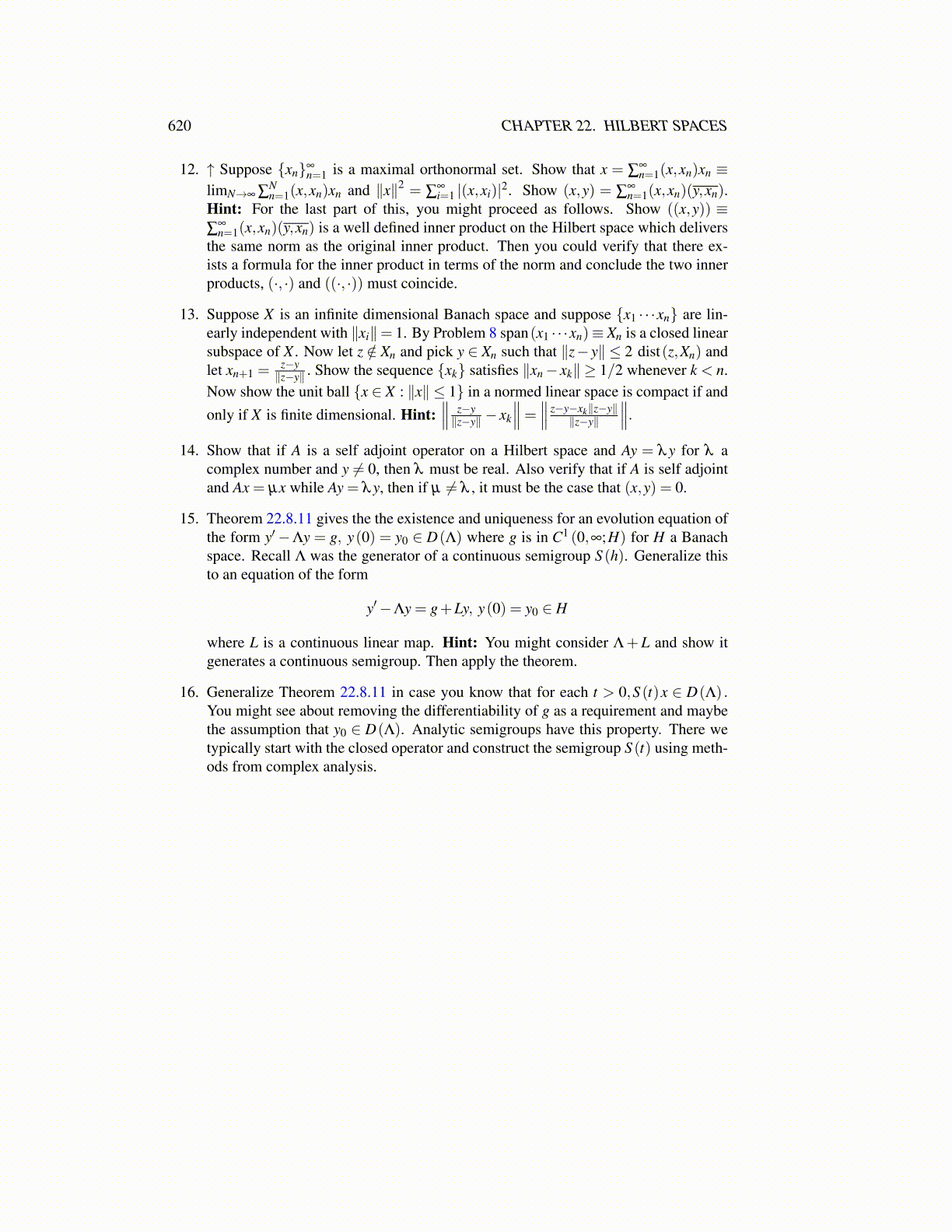
620 CHAPTER 22. HILBERT SPACES
12. ↑ Suppose {xn}∞n=1 is a maximal orthonormal set. Show that x = ∑
∞n=1(x,xn)xn ≡
limN→∞ ∑Nn=1(x,xn)xn and ∥x∥2 = ∑
∞i=1 |(x,xi)|2. Show (x,y) = ∑
∞n=1(x,xn)(y,xn).
Hint: For the last part of this, you might proceed as follows. Show ((x,y)) ≡∑
∞n=1(x,xn)(y,xn) is a well defined inner product on the Hilbert space which delivers
the same norm as the original inner product. Then you could verify that there ex-ists a formula for the inner product in terms of the norm and conclude the two innerproducts, (·, ·) and ((·, ·)) must coincide.
13. Suppose X is an infinite dimensional Banach space and suppose {x1 · · ·xn} are lin-early independent with ∥xi∥= 1. By Problem 8 span(x1 · · ·xn)≡ Xn is a closed linearsubspace of X . Now let z /∈ Xn and pick y ∈ Xn such that ∥z− y∥ ≤ 2 dist(z,Xn) andlet xn+1 =
z−y∥z−y∥ . Show the sequence {xk} satisfies ∥xn− xk∥ ≥ 1/2 whenever k < n.
Now show the unit ball {x ∈ X : ∥x∥ ≤ 1} in a normed linear space is compact if andonly if X is finite dimensional. Hint:
∥∥∥ z−y∥z−y∥ − xk
∥∥∥= ∥∥∥ z−y−xk∥z−y∥∥z−y∥
∥∥∥.14. Show that if A is a self adjoint operator on a Hilbert space and Ay = λy for λ a
complex number and y ̸= 0, then λ must be real. Also verify that if A is self adjointand Ax = µx while Ay = λy, then if µ ̸= λ , it must be the case that (x,y) = 0.
15. Theorem 22.8.11 gives the the existence and uniqueness for an evolution equation ofthe form y′−Λy = g, y(0) = y0 ∈ D(Λ) where g is in C1 (0,∞;H) for H a Banachspace. Recall Λ was the generator of a continuous semigroup S (h). Generalize thisto an equation of the form
y′−Λy = g+Ly, y(0) = y0 ∈ H
where L is a continuous linear map. Hint: You might consider Λ+L and show itgenerates a continuous semigroup. Then apply the theorem.
16. Generalize Theorem 22.8.11 in case you know that for each t > 0,S (t)x ∈ D(Λ) .You might see about removing the differentiability of g as a requirement and maybethe assumption that y0 ∈ D(Λ). Analytic semigroups have this property. There wetypically start with the closed operator and construct the semigroup S (t) using meth-ods from complex analysis.